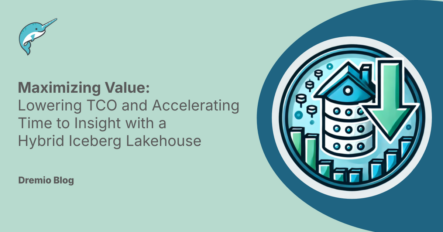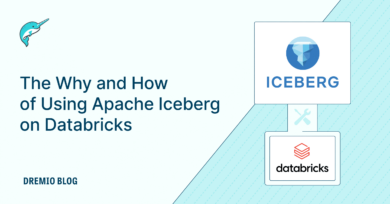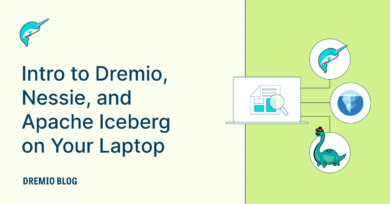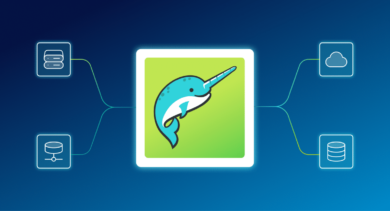7 minute read · October 28, 2024
Maximizing Value: Lowering TCO and Accelerating Time to Insight with a Hybrid Iceberg Lakehouse

· Principal Product Marketing Manager

Organizations are constantly pressured to unlock data insights quickly and efficiently while controlling costs. However, as businesses amass ever-increasing volumes of data across multiple environments—both on-premises and in the cloud—they encounter significant challenges with traditional data architectures. A Hybrid Iceberg Lakehouse, such as the one offered by Dremio, delivers substantial Total Cost of Ownership (TCO) value, cost savings, and faster time to insight. By leveraging open standards, minimizing data movement, and enabling self-service, the Dremio Hybrid Iceberg Lakehouse offers enterprises a transformative approach to modern data management.
1. The Hidden Costs of ETL
Traditional data architectures often rely heavily on Extract, Transform, Load (ETL) processes to move data between systems, leading to complex pipelines that are expensive to build and maintain. Every time data is copied, transferred, or transformed, additional costs accumulate—not just in terms of storage and compute power but also in management and operational overhead.
With Dremio’s Hybrid Iceberg Lakehouse, data can remain in place, whether on-premises or in the cloud, eliminating the need for extensive, costly and time-consuming ETL operations. Organizations can query data directly on the data lake or other data sources without moving it into proprietary data warehouses, enabling real-time analytics with minimal latency. This approach drastically reduces the costs associated with data movement while also accelerating time to value by eliminating bottlenecks in the data pipeline.
2. Faster Time to Insight with Superior Performance
Speed to insight is critical in today’s competitive business landscape, where decisions must be data-driven and timely. The faster organizations can unlock insights from their data, the greater their competitive advantage. Traditional systems often struggle with performance issues, particularly when handling large, distributed datasets.
The Dremio Hybrid Iceberg Lakehouse offers a lightning-fast SQL query engine with built-in query acceleration, delivering sub-second response times even for large datasets. This performance advantage enables analysts and data scientists to generate insights in real time, shortening the time between data ingestion and business impact. WIth a Dremio Lakehouse, organizations can analyze data at scale without compromising on speed. Faster query times translate to quicker decision-making, helping businesses respond to market changes and opportunities with agility.
3. Lower Management Costs with Simplified Data Architecture
Managing data infrastructure can be a significant cost burden for enterprises, especially when dealing with multiple systems and environments. Traditional data warehouses and legacy systems often require extensive IT involvement to manage integrations, data movement, and infrastructure maintenance. These systems also have high licensing and support fees, further increasing TCO.
The Hybrid Iceberg Lakehouse simplifies data management by unifying cloud and on-premises environments into a seamless architecture. With Dremio’s self-service capabilities, data scientists, analysts, and business users can access and analyze data directly, reducing dependency on IT teams.
Dremios Enterprise Catalog for Apache Iceberg provides automated data management features. Capabilities such as automated garbage collection, compaction as well as zero copy data cloning and versioning further reduce the operational overhead associated with large-scale datasets. As a result, organizations benefit from lower management costs and reduced staffing requirements.
4. Enabling Self-Service Analytics to Lower Costs
The shift toward self-service analytics is one of the most significant cost-saving opportunities with the Dremio Hybrid Iceberg Lakehouse. In traditional environments, business users rely heavily on IT teams to prepare datasets, run queries, and deliver reports. This dependency creates bottlenecks and inflates operational costs.
With Dremio’s self-service analytics platform, users across the organization—whether data scientists, analysts, or business stakeholders—can access and query data independently. The user-friendly interface simplifies data exploration and analysis, allowing teams to focus on generating insights without technical bottlenecks. This self-service approach reduces the workload on IT teams, resulting in lower labor costs and faster insight time.
Additionally, Dremio’s GenAI-powered features further enhance the self-service experience. With text-to-SQL capabilities, users can query data in natural language, making analytics accessible to non-technical users. Auto-generated Wiki descriptions and data labels provide context-rich insights, enabling business users to find and understand data quickly. The result is greater efficiency, lower costs, and more democratized access to data-driven decision-making.
5. Repatriating Data from the Cloud for Cost Savings
Cloud adoption has surged in recent years, offering flexibility and scalability for enterprises. However, cloud costs can spiral as organizations scale their data workloads. Storage, data movement, and computing costs continue to rise, forcing many businesses to re-evaluate their cloud strategies. As a result, repatriating some data from the cloud to on-premises has become a growing trend for companies looking to manage costs more effectively.
The Hybrid Iceberg Lakehouse provides a unique advantage, seamlessly integrating cloud and on-premise data environments. This flexibility allows organizations to store large or sensitive datasets on-premises, reducing ongoing cloud storage fees while still leveraging the cloud for other data sets and applications. With Dremio’s hybrid capabilities, organizations avoid vendor lock-in and strategically balance where data and workloads reside to maximize cost efficiency.
6. Open Standards Reduce TCO
Traditional data platforms often lock organizations into proprietary systems, limiting flexibility and lowering costs through licensing fees and vendor dependencies. In contrast, Dremio’s Hybrid Iceberg Lakehouse is built on open source and open standards, such as Apache Iceberg, Apache Parquet, Apache Arrow, and Project Nessie, providing organizations with vendor independence and flexibility that translates into long-term cost savings.
This open architecture allows enterprises to avoid expensive licensing models and enables them to leverage a broader ecosystem of analytical tools. Organizations can easily integrate open-source and proprietary BI platforms and tools, such as dbt, Jupyter, Spark, Tableau, and Power BI. This flexibility reduces TCO and ensures that companies are not locked into a single cloud provider or vendor for their analytics needs.
A Smarter, Cost-Effective Data Strategy
The Dremio Hybrid Iceberg Lakehouse offers a cost-effective and future-proof data strategy for enterprises looking to optimize TCO, reduce operational costs, and accelerate time to value. The lakehouse eliminates the need for expensive data movement and reduces management overhead by enabling seamless data access across on-premises and cloud environments.
Organizations benefit from superior performance, faster insights, and lower operational costs thanks to Dremio’s lightning-fast query engine, automated data management, and self-service capabilities. Open standards ensure independence, giving businesses the flexibility to adapt to changing needs and opportunities.
For enterprises seeking a smarter approach to data management, the Dremio Hybrid Iceberg Lakehouse provides the tools and architecture needed to succeed—offering both cost savings and faster time to insight in today’s rapidly changing business landscape.


